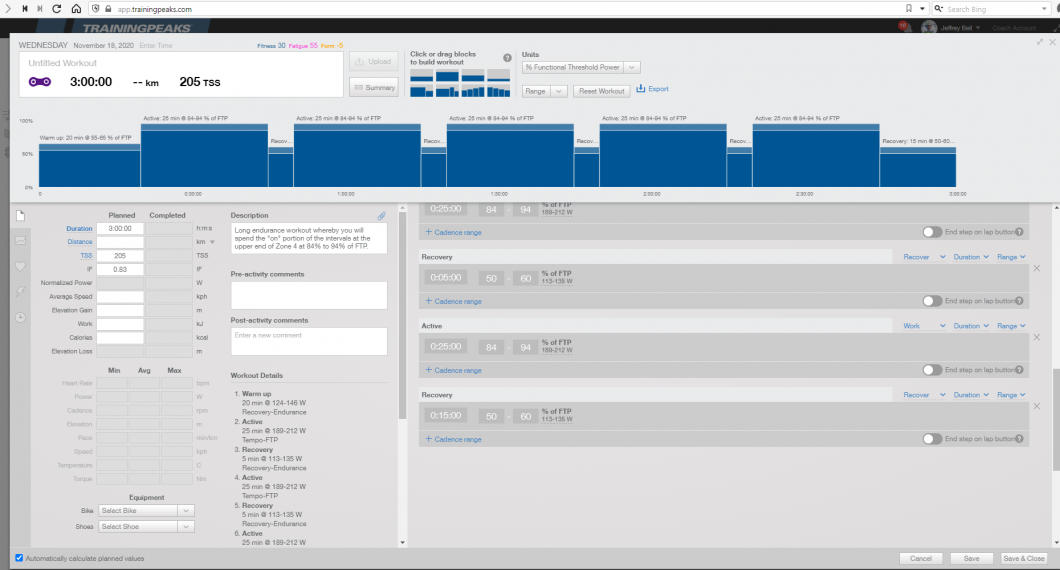Intervals have always been a powerful tool for applying targeted training and generating specific physiological adaptations in cycling, running, strength, and swimming athletes. They have become a much talked about cycling training topic, particularly with the growth in power based cycling training and the development of smart trainers, and the training apps that support and enable the use of these tools for indoor training with power. However, intervals have been a staple of athletic training for decades as they are an effective training tool and they provide many advantages for increasing fitness on the bike.
By simple definition, an interval simply means a period of intensity (effort) followed by a period of reduced intensity (rest) in a repetitive pattern.
Eastern Slopes Cycling, 2021
So why is interval training so effective? The reason for the perceived and practical realized value of interval training is the targeted efficiency and economy that intervals provide. Intervals can have many training purposes that are often fundamental to performance improvement, in particular, I tend to think of the need to raise power usually for a specific duration, to increase or improve fatigue resistance, or build capacity.
Interval training is a type of discontinuous physical training that involves a series of low- to high-intensity exercise blocks interspersed with rest or relief periods. This combination of so-called “on” and “off” can take a multitude of patterns but the application will be typically to stress a physiological system or training focus for a competitive pursuit. The rest periods allow for a buffering of lactic acid from the blood and ensure a certain amount of recovery for the successful completion of the next high-intensity interval. A crucial and much over looked facet of interval training is that the rest periods are as critical as the higher intensity work or “on” periods in an interval workout. It is truly a case of synergistic reliance for an interval workout prescription to be successful.
For example, you would not attempt an interval workout, that was aiming to develop a response in maximal aerobic capacity (VO2max), that prescribed a pattern of 5 intervals of 15 minute “on” and 5 minutes “off” at a level as close to VO2max as possible (e.g. 110% to 120% of FTP), as it would be impossible to complete such an interval duration at that intensity. However, reverse that on and off pattern , i.e., 5 minutes “on” and 15 minutes “off”, and you now have a more physiologically sound and realistic interval pattern.
A particular type of targeted interval workout, such as a max aerobic or VO2max interval workout, could be built with different combinations of time and intensity durations that are all stressing the VO2max intensity band and by applying different combinations of intensity between 105% and 120% of FTP the workout can apply the stress to enable greater or lesser total workload or TSS but still benefit the maximal aerobic system. The classic Coggan Power Levels will still provide adequate guidance and evoke adequate stress in the physiological systems in the general design of intervals (see Figure 2 below).
When doing maximal aerobic efforts, it is typically a mixture of aerobic and anaerobic energy production, and these efforts are most often used in pursuits, attacks, bridging small gaps and short climbs. The anaerobic contribution or W’ (W prime) has to be either offset or depleted to allow VO2 Max intervals to be as “clean” or maximally aerobic as possible, or the intervals need to be at the lower end of Zone 5, but that can put restrictions on the interval quality and effectiveness. Ideally targeting the midrange of FRC/FTP in WKO iLevels will produce the most effective training and repeatability with a typical interval number scenario, (see Figures 2 & 2a below).
Figure 1 below, shows a very typical VO2max interval workout prescription, with 3 minute “on” segments at 120% of FTP, matched with 3 min off segments at 55% of FTP (Zone1), and 5 minutes of recovery between each set of 3 intervals. The Coggan classic levels utilizing a percentage of FTP is useful at efforts below FTP, but when training above FTP, the intensity-time relationship varies between individual athletes, which can have considerable physiological variation and therefore increased the risk of under and over training and failure to adequately exploit the targeted physiological systems.
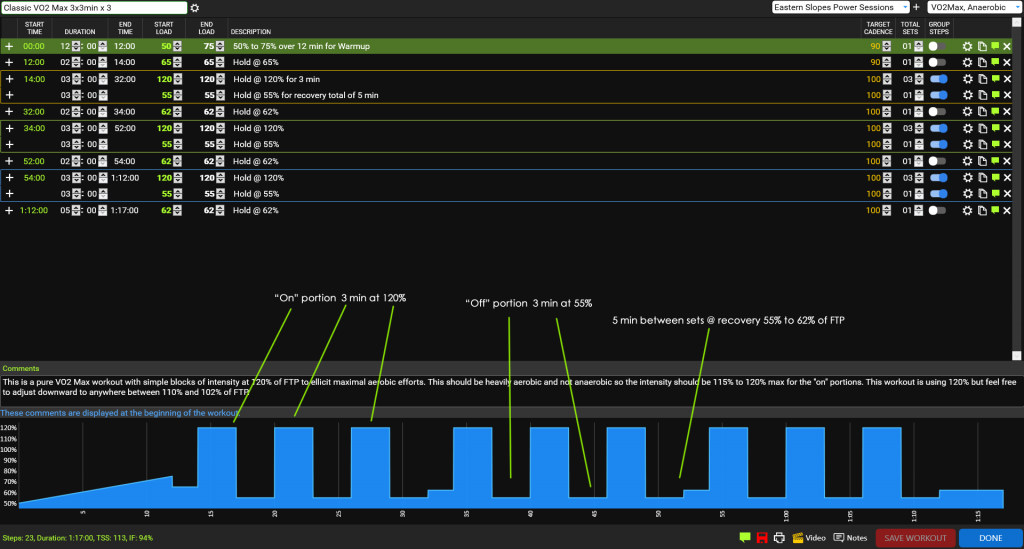
Training Zones and Interval Intensity
When efforts are above an athlete’s FTP or anaerobic threshold, such as with maximal aerobic (VO2max) efforts, or full anaerobic (FRC) efforts of 1 minute or less, the relationship of intensity to energy system response and individual physiology becomes more nuanced and do not necessarily map directly to a specific percentage of FTP. The more useful approach at thee intensities is to look at the power duration relationship more explicitly. In WKO5 software it utilizes the concept of Individualized Training Levels (iLevels) to be distinguished from the so called Classic Coggan Levels.
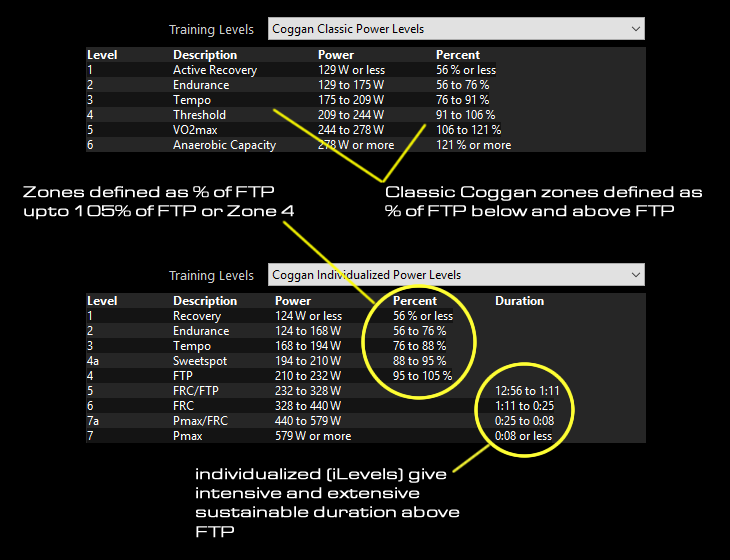
Utilizing a system such as the WKO5 iLevels, the interval upper and lower power targets and parameters of repetitions, recovery and sets, as well as optimized time in zone (TIZ), can be explicitly defined for each athlete. As illustrated below in WKO5, iLevels are explicitly referencing the anaerobic and neuromuscular physiology domains. In WKO5 that is referred to as Functional Reserve Capacity (Anaerobic Work Capacity) or the total amount of work you can do during continuous exercise above your FTP before fatigue occurs, and PMax or the maximal power that can be generated for or a very short period of time over at least a full pedal revolution with both legs.
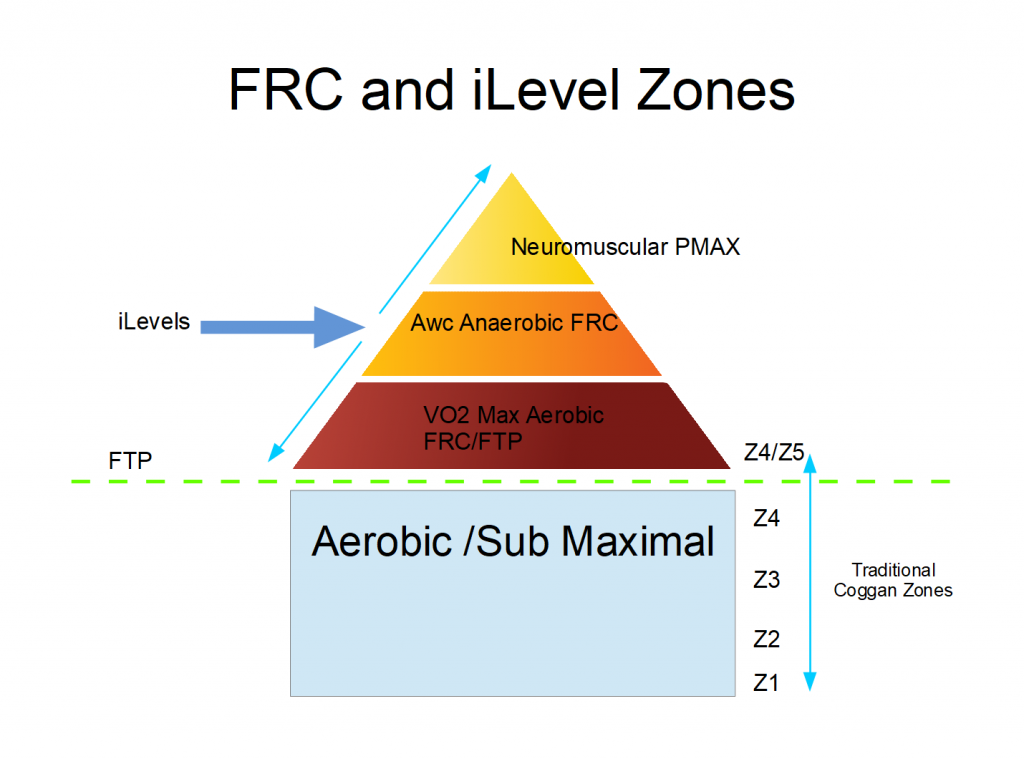
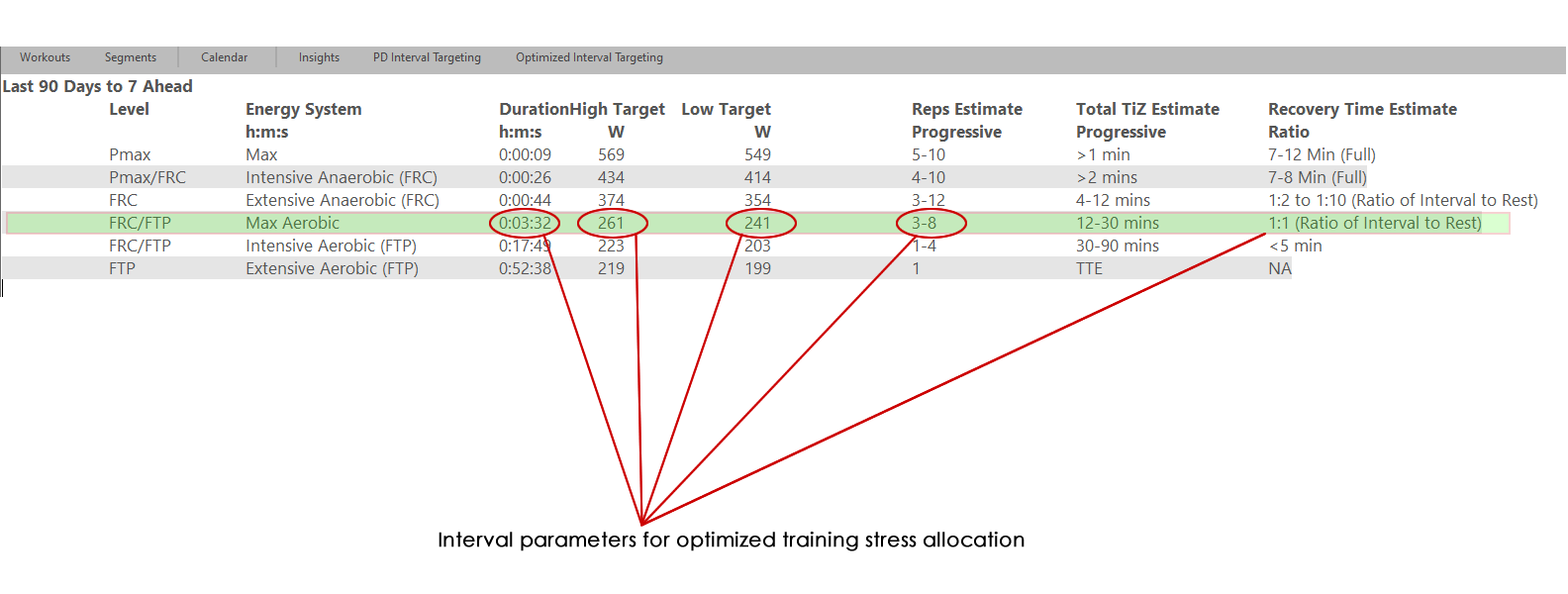
Tim Cusick has written and presented extensively on the use of iLevels as the lead developer of this concept within WKO5. You can read more about the role of iLevels here:
Interval Design Parameters
When designing intervals, we typically consider the following four variables:
- The intensity of each interval
- The duration of each interval
- The rest between each interval
- The total number of intervals or sets (repeatability)
The application of these variables is determined by the training goal of the individual, and it is focused on the energy system that is to be challenged. The three energy systems that can be challenged during interval training are ATP-PC (sprints or shorter intervals less than 30 seconds), anaerobic (30 seconds to 2 minutes so moderate distance or time), and aerobic (3 minutes or more and intensity can factor in, but longer distance or time). For more on the energy systems and their role in cycling training read our discussion here. It can also be effective to further break down both the anaerobic and aerobic energy production into secondary levels of power and endurance.
Such that:
- Aerobic power and aerobic endurance
- Anaerobic power and anaerobic endurance
There are almost an infinite number of ways that each interval workout can be modified and combined
All three energy systems have different workloads and recovery times based on the intensity of the intervals and the time allowed for the buffering of lactic acid and replenishment of ATP so that the following “on” portion interval can be completed at a high rate of work.
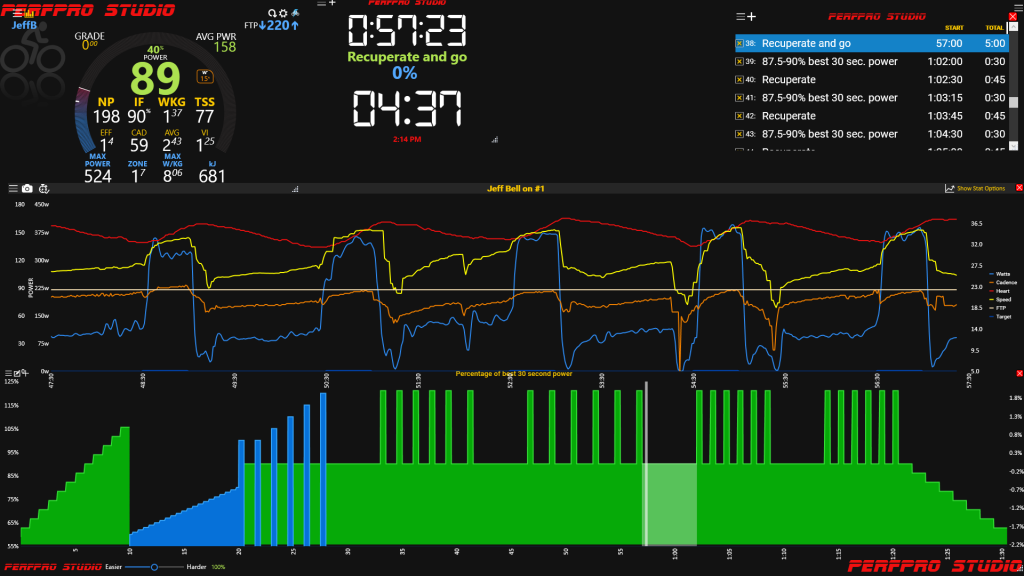
It’s a tricky balance because not only do the duration and intensity of the intervals have an effect on what you’re trying to achieve, so does the recovery period. The critical aspect of interval training is to generate enough training stress to elicit a training effect and the desired adaptation. To measure the training stress with a power meter is straightforward but what is not immediate, and something that often impacts interval training quality is the dosing or total training load of an interval session. Whereby more is not necessarily better and dosing is and should be quite explicit and adhered too during training.
For example, squeezing out extra intervals when the quality or completion of the extra interval(s), and hence the desired training effect is declining, and to simply follow a pattern of thought that “more is better” and working to failure, is counterproductive. It is not the point of effective interval training. Yes sometimes such a scenario can yield some benefit but such training scenarios have an explicit use in very controlled overload training.
The Role of Fatigue and Interval Quality in Workout Design
Designing interval training workouts can be challenging. There are some clear physiological principles and guidelines, but even these leave significant room for interpretation. Many athletes and coaches experiment within the typical boundaries of training levels or zones by adjusting the length and intensity of the work interval, along with the length of the rest interval. They also experiment by increasing or decreasing the number of sets within an interval workout. Why? Intervals are hard work, and we want to make sure we’re maximizing the return on our painful effort; we want to find the best interval workout possible.
I would argue that one element that is often missed with interval use or prescription is the fatigue context. The coach or athlete has to consider what they can achieve at a point in a training workout or period within a training period, in terms of current fatigue and training load. This knowledge will allow the quality and the benefit of the interval sessions to be fully realized. The interval quality of performance is a useful measure for the athlete to be able to know that an interval session is over and continuing to try and squeeze out the intervals will be detrimental and unproductive to fitness and will more than likely result in a sub optimal training effect.
Measuring interval quality and the ability to maintain target effort or power is a useful proxy for measuring the interval success and worth. For example, if a workout calls for 3 sets of 6 intervals and you are not able to complete the last 3 or 4 intervals on the third set at an adequate power, that is only 90% of target, then it is an indication of current fatigue or the validity of the interval prescription at this point in your training week or day.
For certain types of intervals there re also guidelines for power degradation and continued exercising of the interval set are available in many training prescriptions and systems.
I’ve seen a few methods that attempt to quantify the drop in power output over a series of intervals to provide a clear point at which further intervals are not recommended. One of the better ones is provided by Hunter Allen and Andrew Coggan in Training and Racing with a Power Meter.
They recommend using the third interval of a VO2max-interval workout as your benchmark. They recommend stopping if your power output in subsequent intervals drops to more than 15 percent below that level. I think that method works best when you’re doing one long string of VO2max intervals, which I prescribe for some advanced athletes, but for most athletes I prefer to break VO2max intervals into smaller sets.
For example, a VO2max interval session could consist of three sets of three intervals with a 1:1 work/recovery ratio during the set for example 3 min “on” and 3 min “off”, and 5 to 8 minutes of easy spinning recovery between sets. Breaking the session into sets typically allows athletes to accumulate more total work at high power outputs.

Breaking VO2max workouts into sets, however, makes it more difficult to provide a clear-cut stopping point based on fatigue. For example, it’s entirely possible that the third interval of your second set could be 15 percent or more below your power output from the intervals in your first set or even the beginning of the second. But with 5 to 8 minutes of easy spinning recovery before you begin the third set, you may very well recover enough to match or even exceed your performance earlier in the workout.
Rather than automatically cutting your workout short if your power outputs are starting to fade, I recommend first adding some time to the recovery period between intervals. This means that if your power output from one VO2max interval to the next falls by 15 percent or more, add 1 minute to the recovery period immediately following that effort. If the next interval is no better than the one before it – despite the extra recovery time – then you’re done for the day. Don’t add more than 1 additional minute of easy spinning between efforts, and don’t change the recovery periods between sets. If the added recovery time allows you to get through the end of the workout – or even just a few intervals closer to the end – that’s great. Completing the work will help you perform your next VO2max workout without having to add recovery time.
Ultimately you are trying to get a measurable and objectively gauged feeling for your capacity to hit power targets and the impact of accumulating fatigue in your body. This fatigue is made up of the workouts undertaken two to three weeks ago, last week, yesterday, and that which is currently accumulating in the workout. The addition to your ATL and the known training loads and CTL/ATL ratio with your current TSB (Training Stress Balance) will also give you background to the decision to try and complete a high intensity interval workout. If you’re feeling tired when you get on your bike, it’s a good idea to start with a focused warm-up and see if that kick-starts your motivation and energy systems.
After 5 to 10 minutes of moderate-paced riding, complete the following:
- 1 minute FastPedal
- 1 minute easy recovery
- 1 minute FastPedal
- 1 minute easy recovery
- 1 minute VO2max effort
By this point, you should be about 15 minutes into your ride, and you have completed a few efforts. That should give you enough real information to evaluate whether you’re ready to have a high-quality interval session. If you felt like you were really dragging in the VO2max effort, or your power output for the effort was considerably lower than normal for a 1-minute effort, I recommend skipping the scheduled interval session and instead completing a moderate-paced endurance ride.
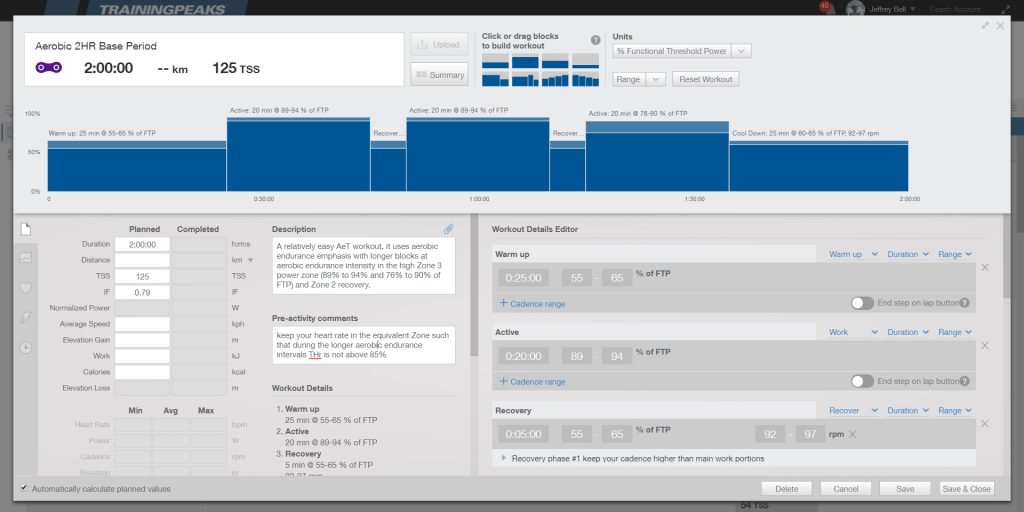
Interval prescription can be guided by the physiological profile of the athlete, such a guide can be found in software like WKO5 which provides interval durations and power output targets that will stress the necessary physiological system(s) and invoke training adaptation.
Types of Cycling Intervals
These are just a few of the more traditional and popular intervals used in cycling training. Really, it’s just scratching the surface. There are almost infinite ways that each interval workout can be modified and combined as well.
- VO2 Max
These target your maximal oxygen uptake and are spent at 106%-120% of FTP. They last anywhere between 1-5 minutes long. - Billats
Sometimes called 30-30s, Billats are VO2 Max intervals of 30 seconds of work followed by 30 seconds of rest. They are typically done 3 sets of 10 with a full recovery in between sets. - Tabata
Tabata intervals are anaerobic focused intervals with 20 seconds of max power followed by 10 seconds of rest. Repeat 8 times to complete a set. The original Tabata workout is only one set. - Over-Unders
This is threshold-specific work that trains your body to deal with metabolic byproducts that come with riding above FTP. These vary in length, but typically a 12 minute over/under interval will alternate 2 minutes at 95% of FTP and 2 minutes at 105% of FTP 3 times. - Sweet Spot
These intervals are all about building your aerobic base and muscular endurance. They are hard enough to drive adaptation but don’t require the recovery demanded from higher-intensity work. They can last anywhere from 8 minutes to 30 minutes spent between 88%-94% of FTP.
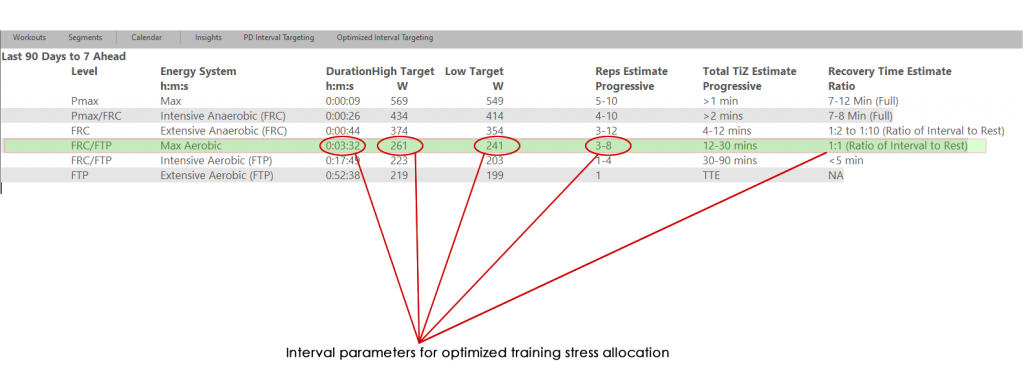
As you get stronger and improve your fitness, your workouts have to deliver a greater workload in order to keep your progress going. You can do this by making intervals longer, performing more of them in a workout, increasing the intensity, or increasing the frequency of interval workouts in your training plan. As you try to plan for progress, you will want to take into account a number of factors, but a good rule of thumb is to start with even easier and more conservative sessions than you think you need to.
For example, if you are a category 5 road racer training for your first racing season, it may be tempting to start your training program with 3x20min Steady-State sessions 2-3 times per week. After all, that is probably a week that you have heard of professional or elite amateur cyclists doing. However, it is important to be realistic with yourself and your experience with interval sessions.
A better place to start would be a workout like 4×12 min Steady-State or 3×15 min Steady-State, sticking to just two workouts a week spaced out with 1-2 days of recovery and/or endurance rides in between. If you are looking to progress those interval sessions, easy ways to do that would be to manipulate either the interval duration or the total number of intervals of the same duration. It is wise to choose just one of those approaches as opposed to doing both at the same time.
If you were doing 4x12min Steady-State workouts, you could progress those to 4x15min Steady-State by adding 3 minutes to each interval length. If you were doing 3x15min Steady-State workouts, one way to progress that session would be to add another interval to do 4x15min Steady-State workouts. An example of how you wouldn’t typically want to progress such an interval workout is by going from a 4x12min Steady-State to a 5x15min Steady-State workout since you are progressing both the interval length and the number of intervals.
Your time-at-intensity or interval work should comprise roughly 20% of your total weekly volume, but if you are new to interval work, something closer to 10-15% could be a better place to start. Over time, your ability to handle more time-at-intensity will improve, and you can justify bumping things up. It should always be a progression, so don’t skip ahead and give your body the time it needs to adapt to an interval-based training program.
As a coach, I tend to describe this as extending the power curve rather than trying to raise it. Increasing the ability to sustain power at a given duration is often a balance of extending time at the power demand or intensity, rather than just increasing the power and either keeping time constant or even increasing both. It will depend upon the physiological parameter being tested and trained.
For intervals extending means training longer intervals but of course if you go too long for a given power intensity you may well fail to achieve the target power and simply be exercising at a lower intensity or power zone for a portion of the interval and you will know that you have reached your ability to hit target power for a given duration and number of repetitions. This goes back to knowing your physiological profile and true power duration and phenotype makeup (what kind of rider are you?).
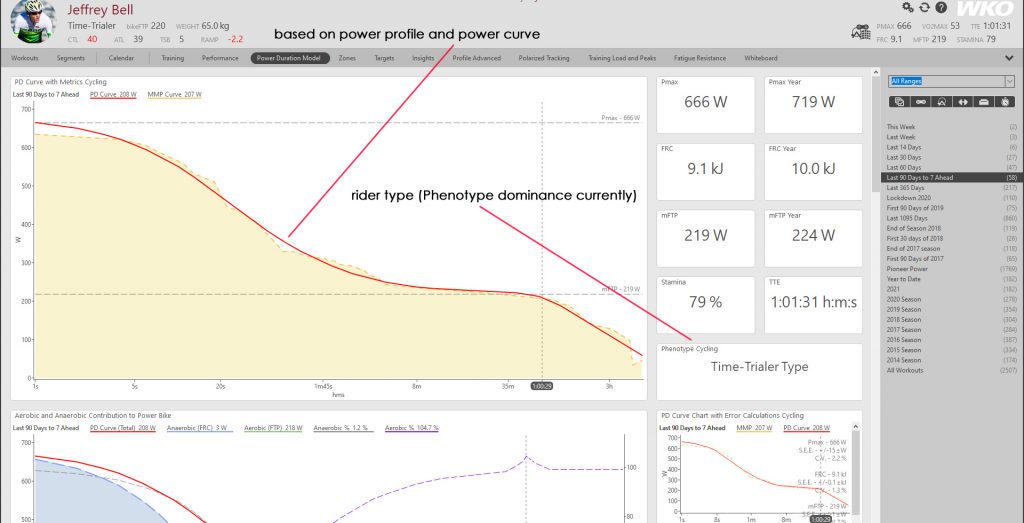
Aerobic Endurance and Sub Threshold Interval Design
When training at or below anaerobic threshold (FTP) or below higher intensity training levels such as aerobic maximum and anaerobic (FRC) training levels, the power based athlete can still utilize an interval based structure. For example a well used format for threshold (FTP) intervals is the 3 x 20 minute or combinations thereof utilizing FTP intervals of 10 to 20 minutes to gain extended time at FTP close to one hour but with the pieces broken into sustainable chunks. Over-Under intervals is another well established format that provides extended training stress in Zone 4.
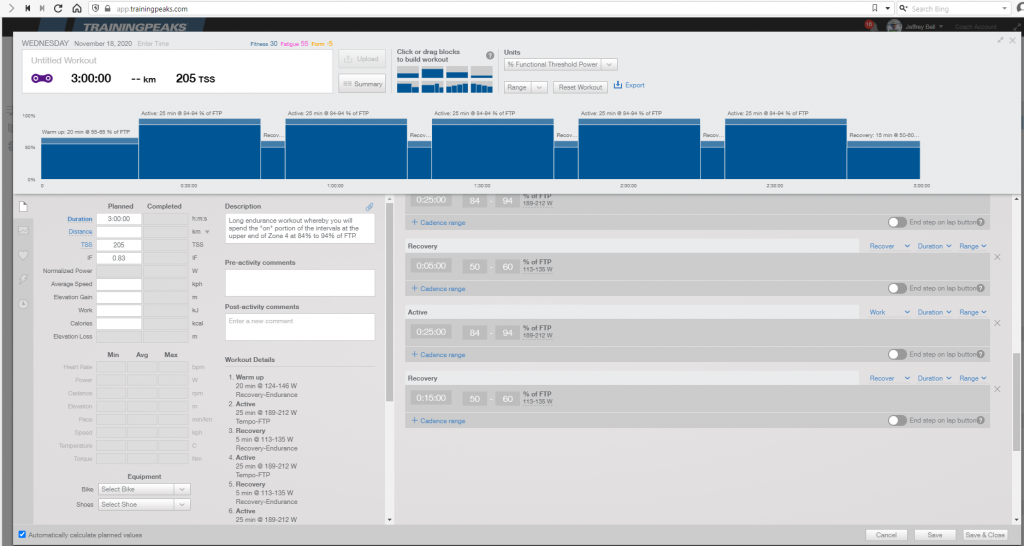
Using and Not Using Intervals to Improve Performance
Despite the obvious benefits of interval workouts, there over use can create too narrow a training load focus and subsequent physiological system development. In addition, although technically an interval can comprise any “on” and “off” effort portion combinations, it is meaningless to describe an “on” portions of say 2 hours in length with an “off” portion of 30 minutes or longer, it becomes physiologically meaningless when power output and duration are controlled that finitely for very extended time periods.
The athlete would simply do a longer ride and keep the power in Zone 2 or below an average of 75% of FTP for the workout and simply recover in Zone 1 or be off target and the overall normalized and average power is going to be the same due to the extended time and lack of variability across the workout. We would just describe such a workout as a Zone 2 extensive or endurance aerobic workout. The average and normalized power for such a workout will be the same as variability is insignificant, even if the athlete bumped into Zone 3 momentarily or dropped into zone 1 during the extended “on” segment.
However if you looked at the power plot of the workout after it would look similar in shape to that in Figure 10, below.
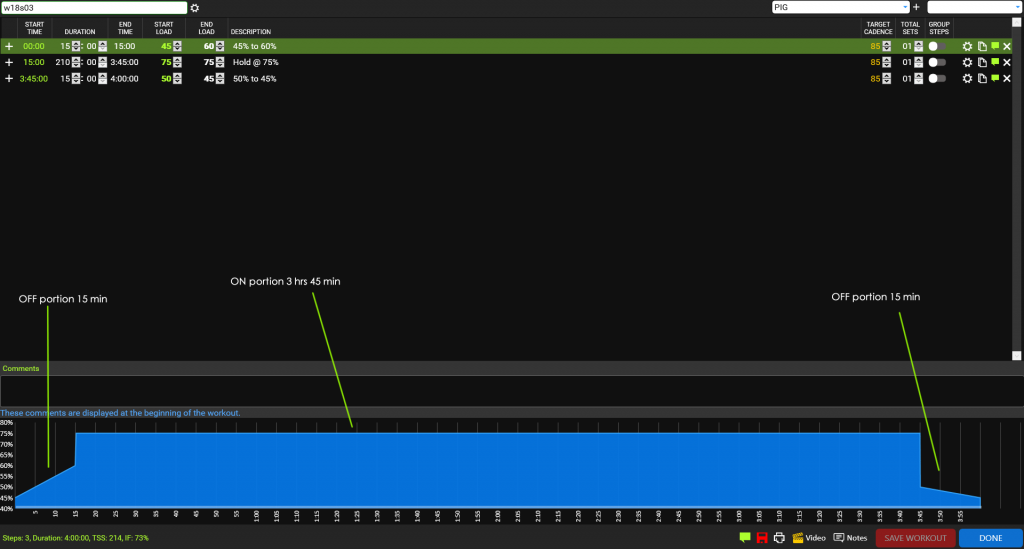
Final Thoughts
As intervals can be combined in patterns in a multitude of variations, to achieve a workout targeting specific or even more general training and physiological demands, it is more important to have a clear idea when you are designing a workout what the the intention or goal of the interval workout is. If. for example, it is to illicit a high maximal aerobic development load and response, then the workout length and combination of interval portions will be more deterministic and regulated around the desired physiological system and the max aerobic workload the athlete can tolerate with current fitness. It is also important to remember that the training stress or TSS of two interval workouts such as two different VO2 Max workouts could vary, especially if they are a mixed workout that also contains some anaerobic or less recovery or higher intensity “off” portions.
In Figure 11 below, the interval workout is targeting 120% of FTP or is effectively a VO2 Max workout but is breaking down the work and recovery portions into 20 by 15 sec “on” portions and 45 second “off” portions to produce a 60 minute workout.
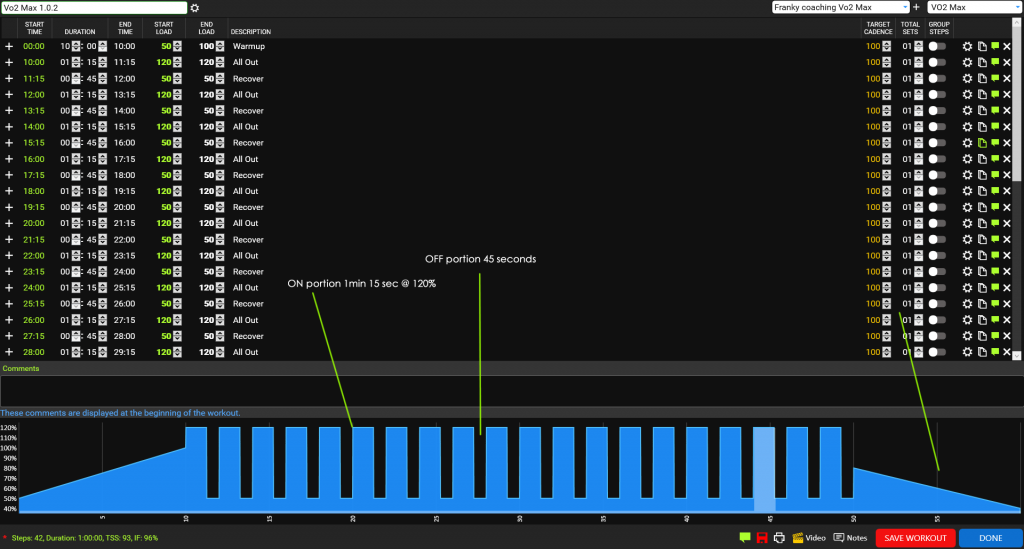
In Figure 12 below, a contrast for a similar length VO2 Max workout is shown with 5 minute “on” intervals @ 115% of FTP and 50% of FTP recovery of 5 minutes. The TSS is almost identical as is the Intensity Factor (IF).

In the above examples both interval workouts will train the maximal aerobic system (VO2 Max), but the workout in Figure 11 is putting the strain on the aerobic system by keeping the “on” and “off ” short and frequent this will make the perceived effort in the first third of the workout seem a lot more tolerable. However, by the mid point of the workout the fatigue will have accumulated to change the athlete’s perceived exertion and the contribution from the anaerobic portion of the systems in the body will have depleted out in both scenarios by the midpoint of both workouts. This will make the maximal aerobic contribution to be fully realized from the intervals.

